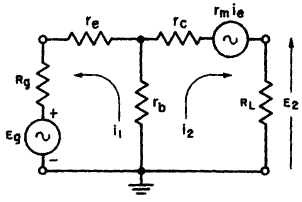| Transistor Basics is a free introductory textbook on transistors and their basic applications. See the editorial for more information.... |

|

Home  The Grounded Base Transistor The Grounded Base Transistor  The Grounded Base Connection The Grounded Base Connection  Equivalent Operating Circuit Equivalent Operating Circuit |
||||||||||||||






|
||||||||||||||
|
Equivalent Operating CircuitAuthor: Leonard Krugman
Fig. 3-9. Equivalent circuit for grounded base connection. At this point, the transistor equivalent circuit must be considered using a practical circuit, such as illustrated in Fig. 3-9. The signal generator Eg, having an internal resistance Rg, is connected between the emitter and the base. Input loop 1:
Output loop 2: -rmie = i1rb + i2 (rc + rb + RL). Since ie = i1, then
Since these two loop equations are independent, they may be solved simultaneously for the two unknown currents i1 and i2. Then
Under ideal conditions, namely, when Rg equals zero, and RL is infinite, it was previously found that r11 = re + rb, r12 = rb, r21 = rb + rm, and r22 = rc + rb. If these values are substituted in equations 3-3 and 3-4, i1 and i2 can be evaluated in terms of the ideal or open-circuit parameters.
|
||||||||||||||
Home  The Grounded Base Transistor The Grounded Base Transistor  The Grounded Base Connection The Grounded Base Connection  Equivalent Operating Circuit Equivalent Operating Circuit |
||||||||||||||
Last Update: 2010-11-17






